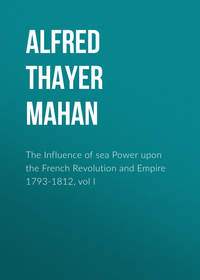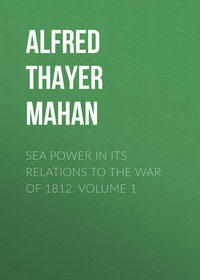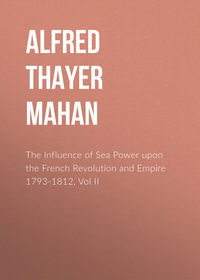 полная версия
полная версияThe Major Operations of the Navies in the War of American Independence
Kempenfelt, before returning to England, sent off express to Hood in the West Indies the fireship Tisiphone, 8, Commander James Saumarez,104—afterwards the distinguished admiral,—with news of the French approach. Saumarez, having been first to Barbados, joined Hood on the 31st of January, 1782, in Basse Terre Roads, on the lee side of St. Kitts; a position from which Hood had dislodged de Grasse six days before by a brilliant manœuvre, resembling that which he had contemplated105 as open to Graves the previous September at Chesapeake Bay for the relief of Cornwallis. The campaign for the year 1782 had opened already with an attack upon St. Kitts by the French army and navy; and the French fleet was even then cruising close at hand to leeward, between St. Kitts and Nevis.
The original intention of de Grasse and de Bouillé had been to capture Barbados, the most important of the Eastern Antilles still remaining to the British; but the heavy trade-winds, which in those days made a winter passage to windward so long and dreary a beat, twice drove them back to port. "The whole French fleet," wrote Hood, "appeared off Santa Lucia on the 17th of last month, endeavouring to get to windward, and having carried away many topmasts and yards in struggling against very squally weather, returned to Fort Royal Bay on the 23d, and on the 28th came out again with forty transports, manœuvring as before." On the 2d of January it disappeared from Santa Lucia, and, after a short stay again at Martinique, proceeded on the 5th to St. Kitts, anchoring in Basse Terre Roads on the 11th. The British garrison retired to Brimstone Hill, a fortified position at the north-west of the island, while the inhabitants surrendered the government to the French, pledging themselves to neutrality. The adjacent island of Nevis capitulated on the same terms on the 20th.
On the 14th of January, an express sent by General Shirley, governor of St. Kitts, had informed Hood at Barbados that a great fleet approaching had been seen from the heights of Nevis on the 10th. Hood at once put to sea, though short of bread and flour, which could not be had, and with the material of his ships in wretched condition. "When the President106 joins," he wrote the Admiralty, "I shall be twenty-two strong, with which I beg you will assure their Lordships I will seek and give battle to the Count de Grasse, be his numbers as they may." On the way a ship reached him with word that the French fleet had invested St. Kitts. On the 21st he anchored at Antigua for repairs and supplies, indispensable for keeping the sea in the operations which he contemplated, the duration of which could not be foreseen. About a thousand troops also were embarked, which, with the marines that could be spared from the squadron, would give a landing force of twenty-four hundred men.
St. Kitts being less than fifty miles from Antigua, Hood doubtless now got accurate information of the enemy's dispositions, and could form a definite, well-matured plan. This seems to have been carefully imparted to all his captains, as was the practice of Nelson, who was the pupil of Hood, if of any one. "At 9.15 A.M. the Admiral made the signal for all flag-officers," says the log of the Canada; "and at 4 P.M. the Admirals and Commodore made the signals for all captains of their divisions." At 5 P.M. of the same day, January 23d, the fleet weighed and stood over for Nevis, round the southern point of which Basse Terre must be approached; for, the channel between Nevis and St. Kitts being impracticable for ships of the line, the two islands were virtually one, and, their common axis lying north-west and south-east, the trade-wind is fair only when coming from the south.
Basse Terre, where de Grasse then was, is about fifteen miles from the south point of Nevis. The roadstead lies east and west, and the French fleet, then twenty-four of the line and two fifties, were anchored without attention to order, three or four deep; the eastern ships so placed that an enemy coming from the southward could reach them with the prevailing trade-wind, against which the western ships could not beat up quickly to their support. This being so, we are told that Hood, starting shortly before sunset with a fair, and probably fresh wind, from a point only sixty miles distant, hoped to come upon the French by surprise at early daybreak, to attack the weather ships, and from them to sail along the hostile order so far as might seem expedient. His column, thus passing in its entirety close to a certain exposed fraction of the enemy, the latter would be cut up in detail by the concentration upon it. The British then, wearing to the southward, would haul their wind, tack, and again stand up to the assault, if the enemy continued to await it.
This reasonable expectation, and skilful conception, was thwarted by a collision, during the night, between a frigate, the Nymphe, 36, and the leading ship of the line, the Alfred, 74. The repairs to the latter delayed the fleet, the approach of which was discovered by daylight. De Grasse therefore put to sea. He imagined Hood's purpose was to throw succours into Brimstone Hill; and moreover the position of the enemy now was between him and four ships of the line momentarily expected from Martinique, one of which joined him on the same day. The French were all under way by sunset, standing to the southward under easy sail, towards the British, who had rounded the south point of Nevis at 1 P.M. Towards dark, Hood went about and stood also to the southward, seemingly in retreat.
During the following night the British tacked several times, to keep their position to windward. At daylight of January 25th, the two fleets were to the westward of Nevis; the British near the island, the French abreast, but several miles to leeward. Foiled in his first spring by an unexpected accident, Hood had not relinquished his enterprise, and now proposed to seize the anchorage quitted by the French, so establishing himself there,—as he had proposed to Graves to do in the Chesapeake,—that he could not be dislodged. For such a defensive position St. Kitts offered special advantages. The anchorage was a narrow ledge, dropping precipitately to very deep water; and it was possible so to place the ships that the enemy could not easily anchor near them.
At 5.30 A.M. of the 25th Hood made the signal to form line of battle on the starboard tack, at one cable interval.107 It is mentioned in the log of the Canada, 74, Captain Cornwallis, that that ship brought-to in her station, fourth from the rear, at 7 o'clock. By 10 o'clock the line was formed, and the ships hove-to in it. At 10.45 the signal was made to fill [to go ahead], the van ships to carry the same sail as the Admiral,—topsails and foresails,—followed, just before noon, by the order to prepare to anchor, with springs on the cables. The French, who were steering south, on the port tack, while the British were hove-to, went about as soon as the latter filled, and stood towards them in bow and quarter line.108
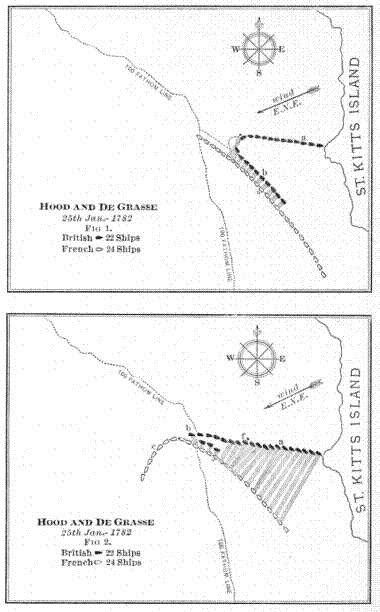
Hood and De Grasse, January 25, 1782, Figures 1 and 2
At noon the British fleet was running along close under the high land of Nevis; so close that the Solebay, 28, one of the frigates inshore of the line, grounded and was wrecked. No signals were needed, except to correct irregularities in the order, for the captains knew what they were to do. The French were approaching steadily, but inevitably dropping astern with reference to the point of the enemy's line for which they were heading. At 2 P.M. de Grasse's flagship, the Ville de Paris, fired several shot at the British rear, which alone she could reach, while his left wing was nearing the Barfleur, Hood's flagship, and the vessels astern of her, the centre of the column, which opened their fire at 2.30. Hood, trusting to his captains, disregarded this threat to the rear half of his force. Signals flew for the van to crowd sail and take its anchorage, and at 3.30 P.M. the leading ships began to anchor in line ahead, (Fig. 1, a), covered as they did so by the broadsides of the rear and the rear centre (b). Upon the latter the French were now keeping up a smart fire. Between the Canada and her next astern, the Prudent, 64,—which was a dull sailer,—there was a considerable interval. Towards it the French admiral pressed, aiming to cut off the three rear vessels; but Cornwallis threw everything aback and closed down upon his consort,—a stirring deed in which he was imitated by the Resolution and Bedford, 74's, immediately ahead of him. De Grasse was thus foiled, but so narrowly, that an officer, looking from one of the ships which had anchored, asserted that for a moment he could perceive the Ville de Paris's jib inside the British line. As the rear of the latter pushed on to its place, it cleared the broadsides of the now anchored van and centre, (Fig. 2, a), and these opened upon the enemy, a great part of whom were strung out behind the British column, without opponents as yet, but hastening up to get their share of the action. Hood's flagship, (f), which anchored at 4.03, opened fire again at 4.40 P.M. Thus, as the Canada and her few companions, who bore the brunt of the day, were shortening sail and rounding-to, (b), still under a hot cannonade, the batteries of their predecessors were ringing out their welcome, and at the same time covering their movements by giving the enemy much else to think about. The Canada, fetching up near the tail of the column and letting go in a hurry, ran out two cables on end, and found upon sounding that she had dropped her anchor in a hundred and fifty fathoms of water. The French column stood on, off soundings, though close to, firing as it passed, and then, wearing to the southward in succession, stood out of action on the port tack, (c), its ineffectual broadsides adding to the grandeur and excitement of the scene, and swelling the glory of Hood's successful daring, of which it is difficult to speak too highly. Lord Robert Manners, the captain of the Resolution, which was fifth ship from the British rear, writing a week later, passed upon this achievement a verdict, which posterity will confirm. "The taking possession of this road was well judged, well conducted, and well executed, though indeed the French had an opportunity—which they missed—of bringing our rear to a very severe account. The van and centre divisions brought to an anchor under the fire of the rear, which was engaged with the enemy's centre (Fig. 1); and then the centre, being at an anchor and properly placed, covered us while we anchored (Fig. 2), making, I think, the most masterly manœuvre I ever saw." Whether regard be had to the thoughtful preparation, the crafty management of the fleet antecedent to the final push, the calculated audacity of the latter, or the firm and sagacious tactical handling from the first moment to the last, Nelson himself never did a more brilliant deed than this of Hood's.109 All firing ceased at 5.30.
Naturally, an order taken up under such conditions needed some rectifying before further battle. As the proper stationing of the fleet depended in great measure upon the position of the van ship, Hood had put a local pilot on board her; but when the action ceased, he found that she was not as close to the shore as he had intended. The rear, on the other hand, was naturally in the most disorder, owing to the circumstances attending its anchorage. Three ships from the rear were consequently directed to place themselves ahead of the van, closing the interval, while others shifted their berths, according to specific directions. The order as finally assumed (Fig. 3) was as follows. The van ship was anchored so close to the shore that it was impossible to pass within her, or, with the prevailing wind, even to reach her, because of a point and shoal just outside, covering her position. From her the line extended in a west-north-west direction to the fifteenth ship,—the Barfleur, 98, Hood's flagship,—when it turned to north, the last six ships being on a north and south line. These six, with their broadsides turned to the westward, prevented a column passing from south to north, the only way one could pass, from enfilading the main line with impunity. The latter covered with its guns the approach from the south. All the ships had springs on their cables, enabling them to turn their sides so as to cover a large arc of a circle with their batteries.
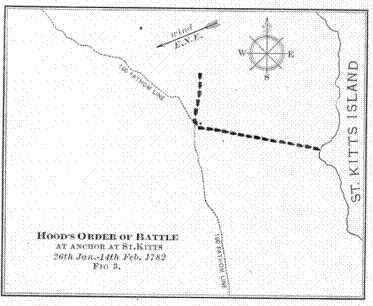
Hood and De Grasse, January 26, 1782, Figure 3
At daylight on the following morning, January 26th, the ships began changing their places, the French being then seven or eight miles distant in the south-south-east. At 7 A.M. they were seen to be approaching in line of battle, under a press of sail, heading for the British van. The Canada, which had begun at 5 A.M. to tackle her 200-odd fathoms of cable, was obliged to cut, whereby "we lost the small bower anchor and two cables with one 8-inch and one 9-inch hawsers, which were bent for springs." The ship had to work to windward to close with the fleet, and was therefore ordered by the Rear-Admiral to keep engaging under way, until 10.50, when a message was sent her to anchor in support of the rear. The action began between 8.30 and 9 A.M., the leading French ship heading for the British van, seemingly with the view of passing round and inside it. Against this attempt Hood's precautions probably were sufficient; but as the enemy's vessel approached, the wind headed her, so that she could only fetch the third ship. The latter, with the vessels ahead and astern, sprung their batteries upon her. "The crash occasioned by their destructive broadsides was so tremendous on board her that whole pieces of plank were seen flying from her off side, ere she could escape the cool concentrated fire of her determined adversaries."110 She put her helm up, and ran along outside the British line, receiving the first fire of each successive ship. Her movement was imitated by her followers, some keeping off sooner, some later; but de Grasse in his flagship not only came close, but pointed his after yards to the wind,111 to move the slower. As he ported his helm when leaving the Barfleur, this brought these sails aback, keeping him a still longer time before the British ships thrown to the rear. "In this he was supported by those ships which were astern, or immediately ahead of him. During this short but tremendous conflict in that part of the field of battle, nothing whatever could be seen of them for upwards of twenty minutes, save de Grasse's white flag at the main-topgallant masthead of the Ville de Paris, gracefully floating above the immense volumes of smoke that enveloped them, or the pennants of those ships which were occasionally perceptible, when an increase of breeze would waft away the smoke."112

François-Joseph-Paul, Comte de Grasse, Marquis de Tilly
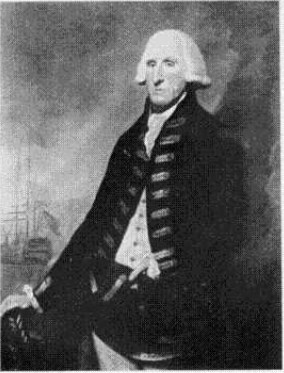
Admiral, Lord Hood
Though most gallantly done, no such routine manœuvre as this could shake Hood's solidly assumed position. The attempt was repeated in the afternoon, but more feebly, and upon the centre and rear only. This also was ineffectual; and Hood was left in triumphant possession of the field. The losses in the several affairs of the two days had been: British, 72 killed, 244 wounded; French, 107 killed, 207 wounded. Thenceforth the French fleet continued cruising to leeward of the island, approaching almost daily, frequently threatening attack, and occasionally exchanging distant shots; but no serious encounter took place. Interest was centred on Brimstone Hill, where alone on the island the British flag still flew. De Grasse awaited its surrender, flattering himself that the British would be forced then to put to sea, and that his fleet, increased by successive arrivals to thirty-two of the line, would then find an opportunity to crush the man who had outwitted and out-manœuvred him on January 25th and 26th. In this hope he was deceived by his own inaptness and his adversary's readiness. Hood was unable to succour Brimstone Hill, for want of troops; the French having landed six thousand men, against which the British twenty-four hundred could effect nothing, either alone or in coöperation with the garrison, which was but twelve hundred strong. The work capitulated on the 13th of February. De Grasse, who had neglected to keep his ships provisioned, went next day to Nevis and anchored there to empty the storeships. That evening Hood called his captains on board, explained his intentions, had them set their watches by his, and at 11 P.M. the cables were cut one by one, lights being left on the buoys, and the fleet silently decamped, passing round the north end of St. Kitts, and so towards Antigua. When de Grasse opened his eyes next morning, the British were no longer to be seen. "Nothing could have been more fortunately executed," wrote Lord Robert Manners, "as not one accident happened from it. Taking the whole in one light, though not successful in the point we aimed at, nevertheless it was well conducted, and has given the enemy a pretty severe check; and if you give him half the credit the enemy does, Sir Samuel Hood will stand very high in the public estimation."
Hood's intention had been to return to Barbados; but on the 25th of February he was joined, to windward of Antigua, by Rodney, who had arrived from England a week earlier, bringing with him twelve ships of the line. The new Commander-in-Chief endeavoured to cut off de Grasse from Martinique, but the French fleet got in there on the 26th. Rodney consequently went to Santa Lucia, to refit Hood's ships, and to prepare for the coming campaign, in which it was understood that the conquest of Jamaica was to be the first object of the allies. An important condition to their success was the arrival of a great convoy, known to be on its way from Brest to repair the losses which Kempenfelt's raid and subsequent bad weather had inflicted in December. Hood suggested to Rodney to halve the fleet, which then numbered thirty-six of the line, letting one part cruise north of Dominica, between that island and Deseada, while the other guarded the southern approach, between Martinique and Santa Lucia. Rodney, however, was unwilling to do this, and adopted a half-measure,—Hood's division being stationed to windward of the north end of Martinique, reaching only as far north as the latitude of Dominica, while the center and rear were abreast of the centre and south of Martinique; all in mutual touch by intermediate vessels. It would seem—reading between the lines—that Hood tried to stretch his cruising ground northwards, in pursuance of his own ideas, but Rodney recalled him. The French convoy consequently passed north of Deseada, convoyed by two ships of the line, and on the 20th of March reached Martinique safely. De Grasse's force was thus raised to thirty-five of the line, including two 50-gun ships, as against the British thirty-six. At the end of the month Rodney returned to Santa Lucia, and there remained at anchor, vigilantly watching the French fleet in Fort Royal by means of a chain of frigates.
The problem now immediately confronting de Grasse—the first step towards the conquest of Jamaica—was extremely difficult. It was to convoy to Cap François the supply vessels essential to his enterprise, besides the merchant fleet bound for France; making in all one hundred and fifty unarmed ships to be protected by his thirty-five sail of the line, in face of the British thirty-six. The trade-wind being fair, he purposed to skirt the inner northern edge of the Caribbean Sea; by which means he would keep close to a succession of friendly ports, wherein the convoy might find refuge in case of need.
With this plan the French armament put to sea on the 8th of April, 1782. The fact being reported promptly to Rodney, by noon his whole fleet was clear of its anchorage and in pursuit. Then was evident the vital importance of Barrington's conquest of Santa Lucia; for, had the British been at Barbados, the most probable alternative, the French movement not only would have been longer unknown, but pursuit would have started from a hundred miles distant, instead of thirty. If the British had met this disadvantage by cruising before Martinique, they would have encountered the difficulty of keeping their ships supplied with water and other necessaries, which Santa Lucia afforded. In truth, without in any degree minimizing the faults of the loser, or the merits of the winner, in the exciting week that followed, the opening situation may be said to have represented on either side an accumulation of neglects or of successes, which at the moment of their occurrence may have seemed individually trivial; a conspicuous warning against the risk incurred by losing single points in the game of war. De Grasse was tremendously handicapped from the outset by the errors of his predecessors and of himself. That the British had Santa Lucia as their outpost was due not only to Barrington's diligence, but also to d'Estaing's slackness and professional timidity; and it may be questioned whether de Grasse himself had shown a proper understanding of strategic conditions, when he neglected that island in favour of Tobago and St. Kitts. Certainly, Hood had feared for it greatly the year before. That the convoy was there to embarrass his movements, may not have been the fault of the French admiral; but it was greatly and entirely his fault that, of the thirty-six ships pursuing him, twenty-one represented a force that he might have crushed in detail a few weeks before,—not to mention the similar failure of April, 1781.113
Large bodies of ships commonly will move less rapidly than small. By 2.30 P.M. of the day of starting, Rodney's look-outs had sighted the French fleet; and before sundown it could be seen from the mastheads of the main body. At 6 next morning, April 9th, the enemy, both fleet and convoy, was visible from the deck of the Barfleur, the flagship of Hood's division, then in the British van. The French bore north-east, distant four to twelve miles, extending from abreast of the centre of Dominica northwards towards Guadeloupe. The British had gained much during the night, and their centre was now off Dominica to leeward of the enemy's rear, which was becalmed under the island. Some fourteen or fifteen of the French van, having opened out the channel between Dominica and Guadeloupe, felt a fresh trade-wind, from east by north, with which they steered north; and their number was gradually increased as individual ships, utilising the catspaws, stole clear of the high land of Dominica. Hood's division in like manner, first among the British, got the breeze, and, with eight ships, the commander of the van stood north in order of battle. To the north-west of him were two French vessels, separated from their consorts and threatened to be cut off (i). These stood boldly down and crossed the head of Hood's column; one passing so close to the leading ship, the Alfred, that the latter had to bear up to let her pass. Rodney had hoisted a signal to engage at 6.38 A.M., but had hauled it down almost immediately, and Hood would not fire without orders. These ships therefore rejoined their main body unharmed. At 8.30 the French hoisted their colours, and shortly afterwards the vessels which had cleared Dominica tacked and stood south, opposite to Hood.
De Grasse now had recognised that he could not escape action, if the convoy kept company. He therefore directed the two 50-gun ships, Expériment and Sagittaire, to accompany it into Guadeloupe, where it arrived safely that day (Position 1, dd); and he decided that the fleet should ply to windward through the channel between Dominica and Guadeloupe, nearly midway in which lies a group of small islands called Les Saintes,—a name at times given to the battle of April 12th. By this course he hoped not only to lead the enemy away from the convoy, but also to throw off pursuit through his superior speed, and so to accomplish his mission unharmed. The French ships, larger, deeper, and with better lines than their opponents, were naturally better sailers, and it may be inferred that even coppering had not entirely overcome this original disadvantage of the British.







